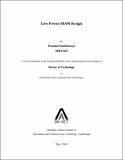Please use this identifier to cite or link to this item:
http://drsr.daiict.ac.in//handle/123456789/210| Title: | Low power SRAM design |
| Authors: | Dubey, Rahul Bambhaniya, Prashant |
| Keywords: | Random access memory Design Random access memory Electronic circuit design Semiconductor storage devices Microprocessors Application specific integrated circuits Integrated circuits Very large scale integration Computer storage devices Testing Semiconductor storage devices |
| Issue Date: | 2008 |
| Publisher: | Dhirubhai Ambani Institute of Information and Communication Technology |
| Citation: | Bambhaniya, Prashant (2008). Low power SRAM design. Dhirubhai Ambani Institute of Information and Communication Technology, ix, 62 p. (Acc.No: T00173) |
| Abstract: | In the past, power dissipation was not constraining factor because of device density and operating frequency was low enough. But nowadays due to increased integration and operating frequency of integrated circuits, power consumption has become an important factor. Battery operated portable devices which performing the high performance processing task also consumes lots of power. The various methodologies are used to reduce the power dissipation by optimizing the parameters that are related to power consumption of circuit. The Static RAM is used as a cache memory in the processor and also has an application in the embedded system. Due to continuous advances in the integrated circuit technology, the density of SRAMs in embedded application has grown substantially in recent years. The SRAM block is becoming indispensable block in the system-on-chips (SoCs). The larger density SRAM block has a highly capacitive bit lines and data lines. The dynamic power of SRAM is mainly due to charging and discharging of highly capacitive lines. To perform the write operation in the SRAM cell to flip the data value, nearly full voltage swings is required on the bit line. This full voltage swing on the highly capacitive bit lines will consumes a greater amount power according to law of CV2f. Thus voltage swing reduction is an effective way to decrease the power dissipation. The current mode sensing technique is proposed to give the small voltage swing on the bit lines during write operation. In the proposed method the layout and simulation is done for the one bit line pair for three different methodologies. The bit line interference of selected cell with adjacent selected and non selected cell is also checked out. The proposed current conveyor method has shown an improvement in terms power dissipation over the voltage write and current read (VWCR) and current write and current read (CWCR) method without comprising the performance. |
| URI: | http://drsr.daiict.ac.in/handle/123456789/210 |
| Appears in Collections: | M Tech Dissertations |
Files in This Item:
| File | Description | Size | Format | |
|---|---|---|---|---|
| 200611043.pdf Restricted Access | 1.75 MB | Adobe PDF |  View/Open Request a copy |
Items in DSpace are protected by copyright, with all rights reserved, unless otherwise indicated.
